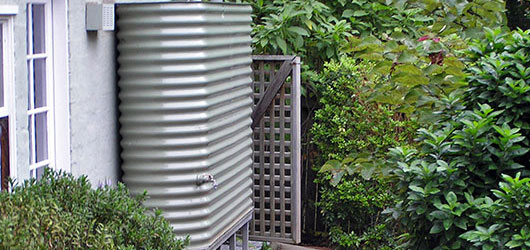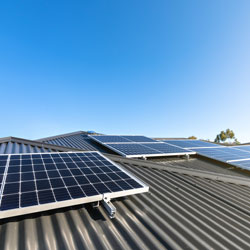Rainwater tanks

Finding the right rainwater harvesting system to suit your household needs requires some research. If you get quotes from at least three rainwater tank suppliers, you'll find the right solution for the best price.
Using rainwater helps conserve valuable mains drinking water and reduces stormwater run-off which can pollute local creeks and rivers.
What can I use my harvested water for?
Harvested water from rainwater tanks is recommended for all non-drinking uses such as:
- Garden watering
- Toilet flushing
- Laundry usage
- Replenishing domestic pools or spas
- Car washing
- Protecting homes from bush fires
What are the typical components of a rainwater harvesting system?
Typical components of a rainwater harvesting system include:
- the roof catchment area and gutters - maximising the roof area flowing to your tank is the best way to maximise your water savings, regardless of your tank size
- the collection system (downpipe, screened leaf diverting rain-head and first-flush water diverter)
- the rainwater tank itself, and
- the supply system (pumps, controllers and filters)
What types of tanks are available?
- Polyethylene or plastic tanks are durable and, because rust isn't an issue, tend to be recommended for people living near the ocean. Other synthetic materials, such as PVC and geotextile, are used for bladder storage.
- Metal tanks are made from corrugated or flat rolled metal, which may be galvanised or coated. They often come with a plastic inner lining that will increase the life of the tank and protect the water quality.
- Fibreglass tanks are rust and chemical-resistant and designed to withstand extreme temperatures. They're not the cheapest option, and more suitable for above-ground installation, while all other types can also be installed below ground.
- Concrete tanks, more often used for agricultural and industrial purposes, won't rust, burn, melt or blow away. They can be bought ready-made, or custom made on-site.
The type you choose depends on a number of factors such as budget, space, water demand and whether the tank will be above or below ground.
For more information visit the Renew | Tankulator website.
What size tank do I need?
The capacity you choose will depend on the size and shape of your household and garden. Tanks can be round, squat, slim line or bladders. Squat tanks fit well under a deck, while slim line tanks are good for narrow spaces. An under floor tank or bladder storage system is a good out-of-sight space saver, but is more expensive.
The ideal size of the tank depends on the following four factors:
- How you intend to use your harvested rainwater
- Size of your roof catchment area
- Local annual rainfall
- How much water your household currently uses
Once you have this information, you can work out how big your tank will need to be to match your requirements. You can determine your household water use by examining your latest water bill.
As a general guide:
- For every 1mm of rain that falls on 1m2 of roof, 1 litre of water is collected. Therefore for a roof that is 100m² (10m x 10m), each 1mm of rainfall will deliver 100 litres of water
- Annual average rainfall in Sydney is 1175mm
- The average person in Sydney consumes around 380 litres of water per day. Approximately 12L of this is for drinking and cooking, 38L is for flushing the toilet, 100L is for bath and shower, 15L dishwasher and washing machine, 195L is for gardens and 12L for other
The Tankulator rainwater tank calculator may help to make the decision process easier.
What other accessories will I need?
Additional equipment that you will need includes:
- mosquito proofing of all openings to prevent breeding
- backflow prevention devices when your tank is plumbed internally
- mains water back up system for internally plumbed tanks – so you don’t run out of water
- signs for all outlets of the rainwater tank stating that it is rainwater
Will I need to buy a pump?
Depending on the location of your tank and whether it is plumbed internally, you may have to install a pump. The size and type of pump you select is something you should discuss with your chosen supplier. Pumps can be noisy so they must be housed in a soundproof enclosure.
What is a first-flush water diversion device?
A first-flush device prevents the initial 10 to 20 litres of rainwater from flowing into the tank, as this water is more likely to be contaminated with leaves and debris from the roof. A first-flush device is essential to maintain a high standard of water quality from your rainwater tank.
Is rainwater safe to drink and to cook with?
NSW Health recommends not to drink or to cook with rainwater harvested in most urban areas. They recommend that people use the public mains water supply for drinking and cooking because it is generally treated by means of filtration, disinfection and fluoridation.
People who choose to use rainwater for drinking and cooking should be aware of potential risks associated with microbiological and chemical contamination. Rainwater tanks in urban areas can be contaminated with airborne contaminants from heavy traffic, smelters and heavy industry.
See also:
Can I harvest rainwater from an asbestos roof?
Rainwater can be collected from most types of roofs, including asbestos / fibro-cement roofs, providing they have not been painted with lead-based paints or coated with bitumen-based material.
Although no longer used in new houses, asbestos may be present in some pre-1970s roofs. Although asbestos fibres are dangerous to health when inhaled in sufficient quantities, the Australian Drinking Water Guidelines state that “the weight of evidence indicates that ingested asbestos is not hazardous to health” and therefore it is not believed that asbestos in drinking water poses a risk.
Asbestos is incorporated into some types of pipe used in distribution of public water supplies.
Note: Asbestos roofing material should, as far as is practicable, be left undisturbed since fibres can be released into the air by actions such as cutting, grinding or drilling. High-pressure roof cleaning methods should not be used on asbestos roofs. Where the roof catchment area has deteriorated badly, it should be replaced with asbestos-free substitutes.
How do I manage and maintain my rainwater harvesting system?
Tanks are low maintenance, not ‘no’ maintenance! Rainwater harvesting systems must be designed to minimise health and safety risks and need to be maintained.
Dust and debris on the roof of the house can contaminate the water. A first-flush water diversion device should be used and regularly cleaned. Gutters and leaf-screens should also be regularly checked. To prevent mosquitoes from entering the tank, all inlets and outlets to the tank need to be blocked with insect-proof screens.
For more detail on managing and using rainwater tanks see the Department of Health publication Guidance on the Use of Rainwater Tanks.
Do I need Council approval?
Most residential water tanks (up to a maximum capacity of 10,000 litres) are exempt from requiring development consent from Council, however, there are conditions to this as outlined in State Environmental Planning Policy (Exempt and Complying Development Codes) 2008 that need to be met.
If your rainwater tank does not meet these planning requirements, development consent may be required prior to tank installation.
To identify if your property benefits from exemption circumstances you can use the online Exempt and Complying Development eModule.
What are the State Environmental Planning Policy requirements?
Rainwater tanks (above ground)
Specified development
The construction or installation of a rainwater tank above ground is development specified for this code if it is not constructed or installed on land in a foreshore area or in an environmentally sensitive area.
Development standards
1. The standards specified for that development are that the development must:
- if it is on land other than land in Zone RU1, RU2, RU3, RU4, RU6, R5, E2, E3 or E4:
- for an educational establishment—not have a capacity of more than 25,000 L, and
- in any other case—not have a capacity more than 10,000 L, and
- be located at least 450mm from each lot boundary, if the tank has a height of more than 1.8m above ground level (existing), and
- if it is on land in Zone RU1, RU2, RU3, RU4, RU6, R5, E2, E3 or E4—be located at least 10m from each lot boundary, and
- be located behind the building line of any road frontage, and
- not rest on the footings of an existing building for support, and
- not require cut and fill of more than 1m below or above ground level (existing), and
- be fitted with a screened rain head designed to ensure self-cleaning and prevent leaf litter entering into the water tank, and
- be fitted with a first-flush device incorporating an automatic resetting valve that causes initial run-off rainwater to bypass the tank, and
- be constructed or installed with inlets and outlets designed to prevent mosquitoes breeding in it, and
- have its overflow connected to an existing stormwater drainage system that does not discharge to an adjoining property, or cause a nuisance to adjoining owners, and
- have a sign affixed to it with a statement to the effect that the water in the tank is rainwater, and
- if it is constructed or installed on or in a heritage item or a draft heritage item—be located in the rear yard.
2. Pumps attached to the development must be housed in an enclosure that is soundproofed.
3. If reticulated water is provided to the lot, the development must not be interconnected with any system supplying drinking water to the lot unless it complies with the relevant water authority’s requirements.
4. In this clause: educational establishment means a building or place used for education (including teaching) and includes a pre-school, a school, a tertiary institution that provides formal education (such as a university or TAFE establishment) and an art gallery or museum that is not used to sell the items displayed in it (whether or not the building or place is also used for accommodation for staff or students).
For more information go to NSW Legislation.
State Environmental Planning Policy (Exempt and Complying Development Codes) 2008 - NSW Legislation (Rainwater tanks - above ground).
Rainwater tanks (below ground)
Specified development
The construction or installation of a rainwater tank below ground is development specified for this code if:
- it is constructed or installed on land in Zone RU1, RU2, RU3, RU4, RU6 or R5, and
- it is not constructed or installed on land that is identified on an Acid Sulfate Map as being Class 1–5, and
- it is not constructed or installed on land that is identified as an environmentally sensitive area.
Development standards
1. The standards specified for that development are that the development must:
- be fitted with a first-flush device that causes initial run-off rainwater to bypass the tank, and
- have a sign affixed to it stating the water in it is rainwater, and
- be constructed or installed to prevent mosquitoes breeding in it, and
- have its overflow connected to an existing stormwater drainage system that does not discharge to an adjoining property, or cause a nuisance to adjoining owners, and
- if it is constructed or installed on or in a heritage item or a draft heritage item—be located in the rear yard.
2. Pumps attached to the development must be housed in an enclosure that is soundproofed.
3. If reticulated water is provided to the lot, the development must not be interconnected with any system supplying drinking water to the lot unless it complies with the relevant water authority’s requirements.
For more information go to NSW Legislation.
State Environmental Planning Policy (Exempt and Complying Development Codes) 2008 - NSW Legislation (Rainwater tanks – below ground).
Rainwater Tank Fact Sheet
Download Council's Rainwater Tank Fact Sheet.
Further information

SunSPoT Solar Calculator
SunSPoT solar calculator is now available to Hornsby Shire residents and businesses, to help you make an informed solar purchasing choice.

Switch to GreenPower
Switching to 100% GreenPower is the best thing you can do for the planet today. GreenPower is a great option for renters and people who can’t install rooftop solar.







